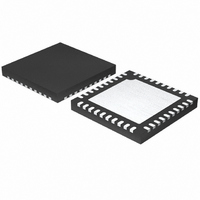MAX9670CTL+ Maxim Integrated Products, MAX9670CTL+ Datasheet - Page 22

MAX9670CTL+
Manufacturer Part Number
MAX9670CTL+
Description
IC AUDIO/VIDEO SWIT DUAL 40TQFN
Manufacturer
Maxim Integrated Products
Datasheet
1.MAX9670CTL.pdf
(44 pages)
Specifications of MAX9670CTL+
Function
Audio/Video Switch
Circuit
2 x SCART
Voltage Supply Source
Single Supply
Voltage - Supply, Single/dual (±)
3.3 V ~ 12 V
Operating Temperature
0°C ~ 70°C
Mounting Type
Surface Mount
Package / Case
40-WFQFN Exposed Pad
For Use With
MAX9670EVKIT+ - EVALUATION KIT FOR MAX9670
Lead Free Status / RoHS Status
Lead free / RoHS Compliant
Low-Power Audio/Video Switch with Audio
Volume Control for Dual SCART Connectors
The audio path has a gain of 4V/V so that the full scale
of the audio output signal is 2V
full scale is desired at the audio outputs, and the full
scale of the audio input signal should be proportionate-
ly decreased below 0.5V
The MAX9670/MAX9671 has four operating modes,
which can be set by writing to bits 6 and 7 of register
10h. See Table 19.
All circuitry is shutdown in the MAX9670/MAX9671
except for the I
tic CMOS logic. Except for register 10h, which sets the
operating mode, the values in all of the other I
ters are preserved while entering, during, and leaving
shutdown mode.
In standby mode, the MAX9670/MAX9671 monitor the
slow-switch signals and decide whether to loop through
the audio/video signals. If the VCR slow switch input
has activity (6V or 12V at the input), the audio/video sig-
nals are looped through from the VCR SCART to the TV
SCART. If the TV slow-switch input has activity, the
audio/video signals are looped through from the TV
SCART to the VCR SCART. If neither the VCR slow-
switch input nor the TV slow switch input show activity,
i.e., both inputs are at ground, no signals are looped
through. If both the VCR slow-switch input and the TV
slow-switch input have activity, the MAX9670/MAX9671
Figure 13. Application circuit to connect audio source to audio
inputs. The 1µF capacitor connected to the ground-referenced
resistors biases the audio signal at ground. The resistors atten-
uate the audio signal.
22
*R1 VALUES
DAC = CS4334/5/8/9: R1 = 4.53kΩ, 1%
DAC = PCM1742: R1 = 5.57kΩ, 1%
______________________________________________________________________________________
STEREO
AUDIO
DACS
2
C interface, which is designed with sta-
1µF
1µF
6.65kΩ
6.65kΩ
RMS
R1*
R1*
.
RMS
Operating Modes
ENC_INL
ENC_INR
. If less than 2V
MAX9670
Standby Mode
Shutdown
2
C regis-
RMS
,
considers this condition to be illegal and does not loop
through any signals.
A finite state machine (Figure 14) controls the operation
of the MAX9670/MAX9671. State 0 is always the initial
state when the MAX9670/MAX9671 enter standby
mode. Table 4 shows the values of the I
state 0. The state machine sets the other I
to the correct values to loop through the audio/video
signals in states 1 and 2 (see Tables 5 and 6). When
the MAX9670/MAX9671 leaves standby mode, the val-
ues in all of the I
preserved so that the operation is not disturbed. For
example, if in standby mode, the MAX9670 is looping
through the audio/video signals from VCR SCART to TV
SCART, and if the microcontroller changes the operat-
ing mode from standby mode to full-power mode, the
audio/video signals continue to be looped through dur-
ing and after the mode change. The user does not
experience any disruption in audio or video service.
The microcontroller can be turned off in standby mode
because the MAX9670/MAX9671 operate autonomous-
ly. Upon power-up, the default operating mode is
standby mode.
In this mode, the MAX9670/MAX9671 are fully on. If
interrupt is enabled, INT goes active low whenever the
slow-switch signal changes; a CVBS signal appears or
disappears; or a CVBS load appears or disappears.
The microcontroller can decide whether to change the
routing configuration or operating mode of the
MAX9670/MAX9671.
This mode is similar to the above mode except that
video input detection and video load detection are not
active. If interrupt is enabled, INT goes active low only
when the slow-switch signal changes.
The quiescent power consumption and average power
consumption of the MAX9670/MAX9671 are very low
because of 3.3V operation and low-power circuit design.
Quiescent power consumption is defined when the
MAX9670/MAX9671 are operating without loads and
without any audio or video signals. Table 7 shows the
quiescent power consumption in all 4 operating modes.
Average power consumption is defined when the MAX9670/
MAX9671 drives typical signals into typical loads. Table 8
shows the average power consumption in full-power
mode and Table 9 shows the input and output conditions.
Full-Power Mode Without Video Input Detection
Full-Power Mode with Video Input Detection
2
C registers except register 10h are
and Video Load Detection
and Video Load Detection
Power Consumption
2
C registers in
2
C registers












